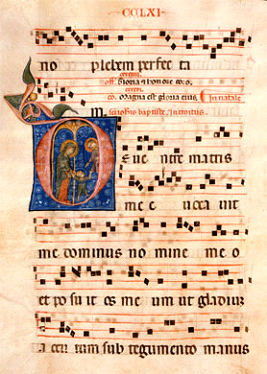
Gregorian Chant

Gregorian chant is the central tradition of Western plainchant, a form of monophonic liturgical chant in Western Christianity that accompanied the celebration of Mass and other ritual services. This vast repertory of chants is the oldest music known, as it is the first repertory to have been adequately notated in the 10th century. In general, the chants were learnt by the viva voce method, that is by following the given example orally, which took many years of experience in the Schola Cantorum.
During the 20th century, Gregorian chant underwent a popular resurgence. Here is a list of links.
Gregorian Chant article in Wikipedia
• Gregorian Chant (Videos)
• Gregorian Chants mp3 free download
• Gregorian Chant (Last.fm)
Samples of Gregorian Chant Play Background Music
Solesmes (Gregorian Chant) Ordinary of the Mass. 7 min.
Te Deum. 5th century monastic chant (solemn)
Gregorian Chant: Choir of the Abbey of Saint Pierre de Solesmes. 12 min.
Gregorian Chant. The Bells of Solesmes. 48 min.Choir of King's College, Cambridge. 7 min.
Gregorian Chants from Assisi. Medieval Lauds. 53 min.
Choir of the Monks of Santo Domingo de Silos, Spain. 51 min.
Illumination - Peaceful Gregorian Chants - Dan Gibson's Solitude [Full Album]
Testimonies -- taken from YouTube viewers.
When it comes to singing sacred music, whether in the medieval Gregorian or in the later classical styles, the Choir of King's College, Cambridge, is at the very top of their game. I believe that only one other choir anywhere comes up to their extraordinary standard, that is the Thomanerchor in Leipzig, which this year is marking 800 years since its foundation. Thank you once again for uploading something quite outstanding.
Gorgeous. I've loved Gregorian chants since my 4th grade music teacher introduced us to it. It's so haunting and uplifting at the same time.
I love this; it's so simple yet so attractive.
Agreed. Today many of us are so caught up in complexity; we fail to see what's simple, profound.
I wish modern church music sounded like this. I enjoy this so much more.. More feeling and emotion. I love this.
Nothing like some heavenly chants to sooth the mind after a day of bloodshed, slaughter and genocide ..
I completely agree Chris. You talk for both of us and many good people.
Peaceful, meditative and soothing.
Although I tend to be a purist in matters of early music, I find these renderings natural and exquisitely beautiful. Definitely lowers the blood pressure and nurtures a sense of peace and calm. Bravo!
I can't describe love; their just are no words
Love is the only true way of the universe, as it is and as it has always been. Namaste
So beautiful. So peaceful. I need to hear this every day.
Peaceful and self soothing moments.
This definitely brings peace to my mind and soul.
Esta mucica gregoriana es berdadera mente hermosa, me gusta mucho.
Can you imagine being there, better yet chanting away through the ecohing centuries' old halls. They say the spirit intercedes for what our words lack the efficency to express. (Romans 8:26) This is what this music does for me, a medium between flesh and spirit.
Where can I get this? I want to put it into my iPhone.
This music brings into my spirit the heavenly realm of God. It bring such a peace as I read God's word. Thank you, Lord, for your presence, that shows your love, joy and peace.
Thanks for sharing your great music.
This music makes me cry in happiness, from what realms is it...I don't understand a word though?
So beautiful, relaxing. A dove representing the Holy Spirit brings me down to earth.
Great music. Makes you feel like you are already there. It lifts your spirit. Spiritually fulfilling. I wish it will not end? . .
. . . . . . . . . . . . . . . . . . . .
How Old Is Your Church?
Gregorian chant originated in Monastic life, in which singing the ‘Divine Service’ nine times a day at the proper hours was upheld according to the Rule of St. Benedict. Singing psalms made up a large part of the life in a monastic community, while a smaller group and soloists sang the chants. In its long history Gregorian Chant has been subjected to many gradual changes and some reforms.
more : http://en.wikipedia.org/wiki/Gregorian_chant
Guido of Arezzo (991/992 – 1050) came up with a method for teaching the singers to learn chants in a short time, and quickly became famous throughout north Italy. However, he attracted the hostility of the other monks at the abbey, prompting him to move to Arezzo, a town which had no abbey, but which did have a large group of cathedral singers, whose training Bishop Tedald invited him to conduct.
more :http://en.wikipedia.org/wiki/Guido_d%27Arezzo
By the 13th century, the neumes of Gregorian chant were usually written in square notation on a staff with four lines and three spaces and a clef marker. In square notation, small groups of ascending notes on a syllable are shown as stacked squares, read from bottom to top, while descending notes are written with diamonds read from left to right. In melismatic chants, in which a syllable may be sung to a large number of notes, a series of smaller such groups of neumes are written in succession, read from left to right. A special symbol called the custos, placed at the end of a system, showed which pitch came next at the start of the following system. Special neumes such as the oriscus, quilisma, and liquescent neumes, indicate particular vocal treatments for these notes. This system of square notation is standard in modern chantbooks.
more : http://en.wikipedia.org/wiki/Neume
Medieval Times. In European history, the Middle Ages, or Medieval period, lasted from the 5th to the 15th century.
Middle Ages. Article in Wikipedia.
See our other site: Lives of the Desert Fathers